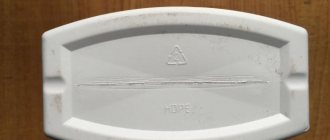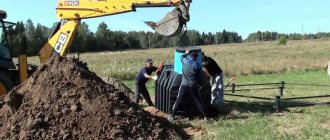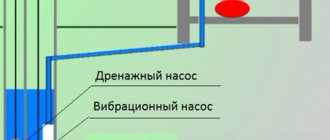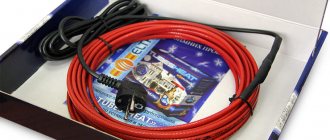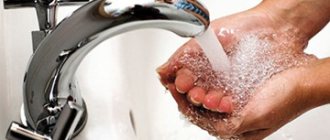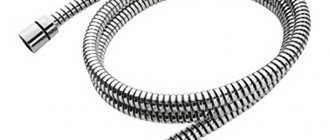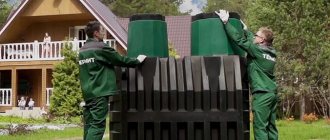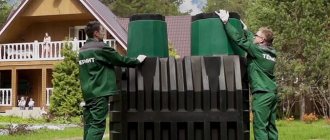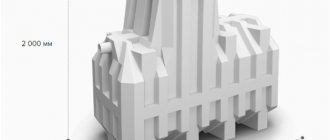Today it is difficult to imagine a modern cottage, country house or dacha without all the amenities in the form of a bathroom, toilet and useful household appliances. However, wastewater from sanitary fixtures and household appliances must be disposed of somewhere. What to do if a town, village or country house is located where there are no centralized sewer networks nearby? The problem of drainage removal can be solved with the help of a Termite septic tank. This is a modern local treatment facility that can collect and process wastewater so efficiently that the purified water can then be used for watering the garden and technical needs. In our article we will look at the features of the device, the positive and negative aspects of the product, based on an analysis of reviews from owners.
Design features
The Termite septic tank is used for high-quality treatment of domestic wastewater. These products are used in places where there is no central sewerage system. Thanks to effective treatment, wastewater can be safely discharged into the soil without fear of environmental pollution.
This equipment is manufactured in the Russian Federation and meets all the requirements of sanitary, construction and environmental standards. The product is very reminiscent of the well-known septic tank Tank. It has a similar design and operating principle, so it is considered its direct competitor.
The Termit cleaning device, like the Tank, is made according to the all-in principle, that is, externally it is a single tank, inside of which there are several separate chambers. Usually there are two or three chambers inside the Termite septic tank. Passing through them, wastewater is purified and clarified. The operation of the product is based on the principles of biological and mechanical cleaning.
The official application from the bookmaker 1xBet is absolutely free and you can click on the link and place bets on sports.
Video principle of operation of the Termit septic tank
The device consists of the following components:
- The storage tank, as in the Tank septic tank, is used to collect wastewater and settle it, as a result of which the solid components of the wastewater settle at the bottom of the tank.
- Bacterial filtration chamber. Here, pre-cleaned and clarified wastewater is further purified by microorganisms that live on special brushes.
- In some Termite septic tanks, as in Tank models, there is a third chamber where the wastewater settles again, which contributes to the precipitation of sediment in the form of activated sludge.
All compartments are connected to each other through an overflow - a special connecting pipe.
Operating principle and characteristics of the AK 47 septic tank
Important: this unit does not require electricity to operate, so the Termit septic tank is a non-volatile installation.
Owner reviews
It is easier to evaluate the positive and negative aspects of any device based on the reviews of those who have already experienced its operation.
I installed a Termit-Profi 2.5 septic tank. Due to the uneven thickness of the walls, it was necessary to install a stiffening frame so that the installation would not be crushed by the ground. He has no complaints about his work. It has been standing for more than 12 months, the sediment has not yet been pumped out.
Vladimir
https://otepleivode.ru/kanalizatsiya/septiki/septik-termit.html#pr6
At my dacha, the groundwater is so close to the surface that it’s impossible to dig even a simple hole. Therefore, it took me a long time to select a suitable septic tank. The choice was made on “Termite-3”, with the installation of an intermediate well and a pump for pumping water from it into the infiltrator. Of course, I had a chance to work. The infiltrator covered it with soil and planted grass. A green hill has emerged and looks beautiful from the outside.
Sergey
https://otepleivode.ru/kanalizatsiya/septiki/septik-termit.html#pr6
I want to thank . The treatment plant was installed two years ago. There were no problems with it the entire time. We live at the dacha seasonally, and they installed Termit 1.2 with a connection to the house, and it still works without any complaints.
Stanislav Vasilievich
https://srbu.ru/septiki/1373-septik-termit-otzyvy.html
Our family had the first time with independent sewer systems three years ago: there was a need for an urgent installation of a septic tank for my mother-in-law. We bought Termit-Profi 1.2. Four days later it was delivered to us and installation began immediately. There were no comments on the work, a year later they pumped it out. As a result, we are thinking about installing the same one at our dacha. By the way, there was no smell, either before or after installation.
Alexey Viktorovich
https://srbu.ru/septiki/1373-septik-termit-otzyvy.html
We installed a five-cubic-meter Termit storage tank. They anchored it to a concrete slab, sprinkled a mixture of sand and cement on half of the container, and the remaining part was filled with concrete to strengthen it against being pressed down by the earth. Nine months after pumping out, the container began to crack. In the area, groundwater is at a level of 1.20 m, and the tightness has been lost.
Guest
https://srbu.ru/septiki/1373-septik-termit-otzyvy.html
Principle of operation
Numerous positive reviews about this unit are associated with its efficiency, which is achieved thanks to the following operating principle:
- Directly from the sewer system, wastewater flows into the first compartment of the septic tank, called the septic tank. Here they settle, as a result of which sediment from large heavy components of the effluent falls to the bottom.
- When the level of liquid clarified wastewater in the first chamber reaches overflow. The water flows into the second compartment. The overflow is located in such a way that sediment and floating fractions from the first chamber cannot enter the second.
- In the second chamber, the water is purified due to the activity of bacteria, as a result of which the wastewater decomposes into water and nitrites. Purified water rises to the surface of the compartment and passes through the filter element. As a result, the wastewater is purified by 60-70%. Since anaerobic bacteria are used for cleaning, there is an unpleasant odor from the structure.
- After this, the pre-purified water enters the irrigation dome. The liquid from this reservoir can be used to water the garden.
- For further wastewater treatment, ground filtration is used. The thing is that there are many organisms in the soil that contribute to the oxidation of chemical compounds. As a result, complete sanitary safety of treated wastewater is achieved. After such multi-stage filtration, wastewater is 95% purified and can be safely discharged into the soil.
Advantages of a septic tank
The positive characteristics of the autonomous sewage system Termite include the following features:
- gravity drainage without connection to electricity;
- ease of use;
- inexpensive components;
- the septic tank is equipped with a flushing filter that does not require constant replacement;
- high quality cast seamless body made of polyethylene;
- two- or three-chamber cleaning system;
- the installation does not depend on the presence of groundwater on the site;
- autonomous operation without human intervention;
- ten-year service life;
- varieties of models with the ability to select a block of modular design.
Compared to an aeration system, a septic tank has one advantage - it saves energy consumption.
Advantages and disadvantages
Many positive reviews are associated with the advantages of the Termite septic tank. Among them are the following:
- The Termit septic tank is an autonomous, non-volatile device.
- The durable design of the product can easily withstand soil pressure and temperature changes.
- From a wide range of modifications of this product, it is easy to choose a model that suits the needs of a particular family. We will look at which septic tank is better to choose for your dacha later in our article.
- Many positive reviews are related to the ease of maintenance of the unit, which is equipped with a powerful flush filter that does not need to be replaced.
- The strength and durability of the structure is achieved through a sealed housing made of high-quality plastic.
- The structure can be used immediately after installation. There is no need to wait 2-3 days for the soil to shrink.
- The Termit septic tank guarantees a high degree of purification of domestic wastewater.
- The building body does not need to be concreted or anchored during installation. This will allow you to save money when installing the product.
- The design can be used in areas with any groundwater level.
- The structure can last up to half a century.
- Acceptable price. A budget model of such a septic tank costs only 240 USD.
Video review of septic tank Termite Pro
Despite numerous positive reviews and a large list of advantages, this product has some disadvantages:
- Unpleasant odor from the building. It appears as a result of the activity of anaerobic bacteria in the second chamber. They emit methane gas, which gives off that smell. To eliminate this smell, you need to use a deep cleaning system and special filters. But this installation is not equipped with them.
- Since the body has a rectangular configuration without rounded corners, the likelihood of bending of the walls in this area increases.
- Many negative user reviews are related to the uneven distribution of load on walls having different thicknesses (from 10 to 20 mm). This significantly reduces the strength of the entire structure.
- Quite a complex installation technology, which is very difficult to do with your own hands.
- The sediment from the first settling chamber must be removed every 3-4 months.
Pros and cons of Termite septic tanks
The advantages of the Termite septic tank are as follows:
- A wide range allowing you to choose a model for any occasion;
- High level of purification (when using an infiltrator in the septic tank in question, it reaches 95–98%);
- Affordability in terms of the cost of the Termit VOC itself and its installation;
- Energy independence, which is very important for holiday villages remote from large cities;
- Full factory readiness of the septic tank for operation immediately after installation;
- Reliability, seamlessness and durability (up to 50 years) of the body.
Among the Termite septic tank models there are modifications both for normal conditions and for areas with high groundwater level. Plus, there is a solution for any number of people in the family. Moreover, if two dozen residents are planned to live in a house, then it is better to take a more productive autonomous station with aerobics.
The Termite septic tank has only two disadvantages:
- The need for additional treatment using an infiltrator or drainage well;
- It is mandatory to install a heavy “anchor” under the hull in case of high groundwater.
During installation, it is necessary to ensure that the Termite septic tank is filled evenly from the outside and filled with water. The stiffening ribs of the body may not withstand it if the chambers inside the VOC are empty. This is not cement-sand tiles or bricks, whose compressive strength is an order of magnitude higher. With strong external pressure, the polyethylene walls may well break through.
Video of how a Termite septic tank was crushed in the spring:
The lineup
Thanks to the variety of modifications of the Termit septic tank, you can choose a model to suit the needs of your family. So, the manufacturer offers the following models:
Leader septic tank review
- The Termit 1f model has a productivity of 0.35 m³/day. and volume 1.2 m³. It is better to choose such a product for a summer house or a house where 1-2 people live. This modification is able to process wastewater from two sinks, a toilet, a shower and one household appliance. Model price 190 USD
- Termite 1.5f can serve a family of 2-3 people. It has a capacity of 0.5 m³ of wastewater per day. The cost of this modification is 230 USD.
- The septic tank model 2f is much better than previous modifications, since it has the following characteristics:
- storage tank capacity – 2 thousand liters;
- model 2f has a body with increased wall thickness - 1.5-2 cm;
- dimensions – 1.8 m x 1.2 m x 2.05 m (height);
- the unit is equipped with two chambers;
- the productivity of the 2f model is 0.7 m³ per day;
- weight – 140 kg;
- modification 2f can serve a house with 2-4 residents;
- the unit can process wastewater from two toilets, four sinks, a bathtub, a shower and two household appliances;
- The septic tank is equipped with a filter made of synthetic fabric, weighting material and pumice. Colonies of beneficial bacteria live on it;
- model price – 290 USD
- The septic tank modification 3f has no less outstanding characteristics:
- this is a three-chamber product;
- the volume of the entire structure is 3 thousand liters;
- dimensions – 2.2 m x 1.2 m x 2.04 m (height);
- case wall thickness – 2 cm;
- structure weight – 185 kg;
- the body is made of linear rotational polyethylene;
- the unit is equipped with a filter element;
- the capacity of the structure is from 1 to 1.2 m³ per day;
- the product can serve a family of 4-6 people;
- to such a septic tank you can connect all those sanitary fixtures and household appliances that were named in the previous model, plus add a jacuzzi;
- product price – 370 USD
- The Termit septic tank, modification 5f, is capable of serving a family of 7-11 people. Its storage tank can hold 5.5 m³. This is a three-chamber design, equipped with a filter device. The unit's productivity reaches 2.4 m³ of wastewater per day.
Description and principle of operation
The Termite septic tank is manufactured in the form of a cube or parallelepiped with one or two necks. The body of this VOC is sealed, solid cast and with stiffening ribs on all sides. It is made of polyethylene. Moreover, the manufacturer uses only primary raw materials; by definition, there is no recycled plastic at the plant.
Type of septic tank Termite for a summer residence
A typical Termite septic tank consists of three chambers inside:
- To receive wastewater, sediment heavy particles and release a fatty film on top of the water.
- For settling (final clarification).
- For the processing of organic matter by anaerobic bacteria.
Septic tank Termite in section
In some designs, the second compartment is combined with the first. They differ from the standard solution by having only one neck.
In the third (last) chamber of the septic tank there is a biofilter made of synthetic fabric and microorganisms on it, as well as another filter with pumice as a filler. Termit produces output water with a purification level of around 75–85%. Then it is sent to an infiltrator, which brings the purification percentage to 98, or to a sump for pumping out using sewage trucks.
Moreover, if the option with post-treatment by drainage is chosen, then the design of the house and the layout of the site should be immediately carried out taking into account the installation of this filter on a gravel bed. Then it will be difficult to find a place for it and a septic tank. The soil moisture near the infiltrator is always higher than at a distance from it. It’s definitely not worth using the same gas blocks or timber to build buildings next to it.
Manufacturing a septic tank at the factory
Installation features
Installation of a Termit septic tank is carried out in several ways, depending on the type of soil:
- In soils with normal absorption, an installation scheme using an irrigation dome is used. At the same time, the capacity of the irrigation tank depends on the performance of the treatment plant.
- Also, for soils with normal absorption, an installation scheme using drainage pipes can be used.
- For sandy soils with low groundwater levels (more than 1.5 m), an installation method is used with the collection of treated wastewater in a filtration well.
- In areas with high groundwater levels, an installation scheme is used using an intermediate well, drainage pumping equipment and a check valve.
- If a consistently high level of groundwater is observed in the area, then an installation scheme is implemented in which the irrigation dome is raised above the ground surface and carefully insulated with a layer of soil.
- Sometimes, under the same conditions, drainage pumping equipment is located in a well.
- If installation needs to be done on clay soils with poor absorption capacity, then the Termite septic tank is installed in conjunction with a filtration field. This field consists of layers of crushed stone and sand. After purification in this field, the water enters the drainage well, and from there it is discharged onto the terrain.
Types and characteristics
The range of Termite septic tanks includes 3 lines of devices: Pro, Standard and Transformer.
Series "Standard"
The “Standard” line of septic tanks is made of linear polyethylene. The thickness of the chamber walls for all products is up to 15 mm. If you buy a Termite septic tank for a summer residence, then the “Standard 2.0” model ideally suits the living conditions of 3-4 people due to its small size and low productivity. But the “Standard 5.5” model is better suited for small cafes and mini-hotels. The “Standard 2.0” model has 2 cameras. The remaining models are three-chamber.
The hatch necks have diameters of 50 and 65 cm.
Septic tanks of the “Standard” line
| Options | Standard 2.0 | Standard 3.0 | Standard 3.5 | Standard 5.5 |
| Overall volume | 2000 l | 3000 l | 3500 l | 5500 l |
| Performance | 700 l/day | 1200 l/day | 1400 l/day | 2200 l/day |
| Number of persons | 4 | 6 | 7 | 12 |
| Dimensions | 1595 x 1155 x 2005 mm | 2390 x 1155 x 1905 mm | 2410 x 1190 x 2005 mm | 2220 x 1650 x 2395 mm |
| Number of necks | 1 | 2 | 2 | 2 |
| Septic tank weight | 105 kg | 135 kg | 175 kg | 215 kg |
Series "Pro"
Septic tanks of the “Pro” line are made from linear polyethylene. The products are characterized by increased chamber wall thickness - up to 20 mm. Accordingly, the strength of such devices is also increased. Models with a total volume of up to 2.5 liters inclusive have 2 chambers. Starting with the “Profi 3.0” model, septic tanks are equipped with three-chamber tanks. For a small summer cottage, it is recommended to choose the “Profi 1.2” model, intended for houses with an area of up to 100 square meters. And the “Profi 2.0” model is suitable for a house with an area of up to 200 square meters. More productive options are selected depending on the number of people living in the house.
Septic tanks of the “Pro” line
| Options | Pro 1.2 | Pro 2.0 | Pro 2.5 | Pro 3.0 | Pro 3.5 | Pro 5.5 |
| Overall volume | 1200 l | 2000 l | 2500 l | 3000 l | 3500 l | 5500 l |
| Performance | 400 l/day | 800 l/day | 1000 l/day | 1200 l/day | 1800 l/day | 2200 l/day |
| Number of persons | 2 | 4 | 5 | 6 | 7 | 12 |
| Dimensions | 1340 x 1160 x 1565 mm | 1595 x 1155 x 2005 mm | 2000 x 1155 x 2005 mm | 2390 x 1155 x 1905 mm | 2410 x 1190 x 2005 mm | 2220 x 1650 x 2395 mm |
| Number of necks | 1 | 1 | 2 | 2 | 2 | 2 |
| Septic tank weight | 80 kg | 115 kg | 135 kg | 165 kg | 185 kg | 265 kg |
Transformer series
Septic tank Termit transformer of all modifications is made of linear high-density polyethylene. The septic tank is solid. Inside the body there is a cast bulb, which gives the septic tank additional rigidity, preventing deformation of the walls. All models in this series have 4 cameras. This is what distinguishes them from other lines.
Septic tanks "Transformer" have letter indices:
- "S" - gravity cleaning system.
- "PR" - forced cleaning system. The septic tank kit includes a drainage pump. Purified water is collected in the 4th chamber, from where it is forcibly pumped out by a pump.
"Transformer S" is non-volatile. The Transformer PR model is partially volatile. Requires power to operate the sump pump.
Septic tanks of the “Transformer” line
| Options | 1.5 | 2.0 | 2.5 | 3.0 |
| Overall volume | 1500 l | 2000 l | 2500 l | 3000 l |
| Productivity (l/day) | 600 | 800 | 1000 | 1200 |
| Number of persons | 3 | 4 | 5 | 6 |
| Dimensions | 2000 x 800 x 2000 mm | 2000 x 1000 x 2100 mm | 2050 x 1050 x 2110 mm | 2190 x 1200 x 2070 mm |
| Number of necks | 1 | 1 | 1 | 1 |
| Septic tank weight | 110 kg | 130 kg | 145 kg | 170 kg |
Advice: Choose the volume of the septic tank based on the number of people who will live permanently or temporarily in the house. You should not overpay for volume that will not be in demand.
DIY installation
If you decide to carry out the installation yourself, then you should adhere to the following sequence of actions:
- First you need to dig a pit for a septic tank and a trench for laying sewer pipes. The dimensions of the pit must exceed the dimensions of the treatment facility by 200-30 mm. The trench for the pipes is dug below the freezing mark and has a slope towards the septic tank at the rate of 2 cm for each meter of length.
- At the bottom of the pit there is a sand cushion 250-300 mm thick.
- The bottom of the pit under the sprinkler is covered with a layer of gravel 400 mm high.
- At the bottom of the trenches for sewer pipes, a sand cushion 10-15 cm high is placed.
- The outlet pipe is laid in a trench with a slope of 1 cm per meter of length. The pipe is carefully insulated.
- Using lifting equipment, the septic tank is installed in the pit.
- The pit is backfilled with a mixture of sand and cement in a ratio of 5 to 1. The mixture is compacted every 20-25 cm. When filling the chamber, the septic tank must be filled with water. In this case, the water level should be slightly higher than the backfill level (200-300 mm).
Important: backfilling work is carried out manually without the use of construction equipment.
- Next, the filtration element is installed. Sewer and drainage pipes are connected to the septic tank pipes. The joints are treated with sealant.
Video on installing a Termite septic tank
Attention: since the septic tank poses a potential threat to the environment, its installation can only be done after a detailed design has been developed and approved by the SES. It is also necessary to obtain permission to operate the treatment plant.
Installation and Installation
To equip the Termite, in addition to the factory container itself, you will need to prepare available materials and tools:
- shovel;
- container for mixing cement mortar;
- building level;
- roulette;
- sewer pipes for supplying and discharging wastewater;
- fitting;
- cement;
- sealant;
- sand.
The installation of “Termite” itself takes place in several stages:
- First choose the installation location . When choosing an installation location, it is important to take into account the possibility of access by a sewage disposal truck to pump out sludge from settling tanks. But there should not be a road above the septic tank.
- Excavation work is carried out at the selected site , which includes preparing a pit for a septic tank. The pit should exceed the dimensions of the tank by 30 cm on each side. The bottom of the pit is leveled. A concrete base is poured onto it, into which mounting loops are installed to secure the septic tank.
- Release the container into the pit . It is important to make sure that it is level.
- Fix the tank to the concrete bottom with slings.
- The inlet and outlet pipelines are connected to the septic tank , which must run with a slope of 2-3 cm so that the wastewater moves by gravity. The joints are treated with sealant.
- The container is backfilled first with a sand-cement mixture, then with soil.
The septic tank should be 5 m away from the house, and 30-50 m away from underground sources of drinking water . At the same time, you should not remove the wastewater disposal system from your home by 10 meters or more. If this has to be done, it will be necessary to install inspection wells on the pipeline.
also necessary to take care of the arrangement of soil filtration. offers sprinklers to complete its Termit septic tanks . You can build a filtration field using drainage pipes or a filtration well. It all depends on the type of soil and your financial capabilities.
Maintenance and operation
In order for the septic tank to serve you as long as possible, it must be used correctly and regularly performed maintenance, which includes the following activities:
- To speed up waste processing and increase the efficiency of wastewater treatment, it is necessary to use special biological products.
- The second chamber of the unit is cleaned of sludge deposits once a year using a sewage disposal machine.
- From time to time it is necessary to mix the material with microorganisms.
Model range of termite septic tank and price with turnkey installation
The main models are laid out for you, and we will answer the question of how much a termite septic tank will cost, price with turnkey installation, see the table:
The lineup:
Optional equipment:
Typically, the installation cost will include:
- Sewer pipe 4 meters long and 110 mm in diameter and materials.
- Excavation.
- Insulation for septic tank and pipe.
- Cement, sand.
- Installation work.
Please note that when ordering a termite septic tank with turnkey installation, the seller will bear all responsibility for poor-quality installation, and if the septic tank is damaged as a result of improper installation, the structure will be replaced or repaired. The main thing is that you have in your hands the corresponding contract and the installation certificate with the signatures of the employees.
Operating principle
The wastewater flows into the working compartment by gravity, thanks to the special slope of the pipe. Here the fermentation process occurs, and large particles settle to the bottom. The waters are then sent to a biological reactor, and fermentation begins. Anaerobic bacteria react with organic compounds.
At the next stage, cleaning occurs in the first aeration compartment, where, under the influence of air forced by the fan, the wastewater begins to mix with activated sludge. After this, the wastewater is sent to the next aeration tank for further treatment using aerobic microorganisms. As a result, activated sludge settles in a special compartment. The resulting water can be discharged into the terrain. Thanks to the multi-stage cleaning process, a record cleaning rate of at least 98% is achieved.
How do septic tanks work?
The operating principle of the cleaning unit is standard:
- the first chamber serves as a storage tank and settling tank. Over a certain period of time, the water is cleared of heavy impurities that settle at the bottom of the compartment;
- the second chamber, into which wastewater without large particles enters, is equipped with a biofilter. The main process of water purification is carried out in this compartment;
- if the septic tank is equipped with a third chamber, then it, like the first, serves as a sump.
Since the Termit septic tank is not a deep cleaning station, infiltrators or filtration (drainage) wells are used to dispose of wastewater.
The operating principle of a two-chamber septic tank Termit
Septic tanks are capable of purifying wastewater by 75% - 80%, which does not allow the water to be used a second time, even for technical purposes.
Preparation for installation work
Despite the fact that Termit sewerage equipment has an official certificate of sanitary standards, if installed incorrectly, it can still cause harm to the environment and human health. Therefore, without a permit from the SES, it is strictly prohibited to independently install a thermoseptic tank at your own discretion. According to consumer recommendations, it is better to invite a specialist to draw up a working draft. This is due to the fact that only he can, according to the construction requirements of SNiP No. 2.04.03-85; SNiP No. 2.04.04-84; SNiP No. 2.04.01-85 and sanitary standards, such as SanPin 2.1.5.980-00, SanPin 2.2.1/2.1.1.1200-03, design a safe location of cleaning equipment.
Let's consider the most important requirements for installing a Termite septic tank:
- Cleaning equipment must be located 2 meters from the dividing fence between neighbors;
- It is not recommended to install the product closer than 5 meters to a living space;
- The sewage system for waste treatment should not be closer than 10 meters to the pipelines through which drinking water enters the premises;
- The recommended distance from the purification equipment to the water intake well is 20 meters;
- There must be free passage for a sewage truck to the location of the septic tank.
All these requirements are based on preventing waste liquid from entering water wells and aquifers under the ground. Otherwise, when harmful bacteria get into drinking water, a source of infectious diseases may arise.
Important! The installation of a Termit septic tank must comply with all the requirements, otherwise the consumer will incur a large fine for violating sanitary legislation.

